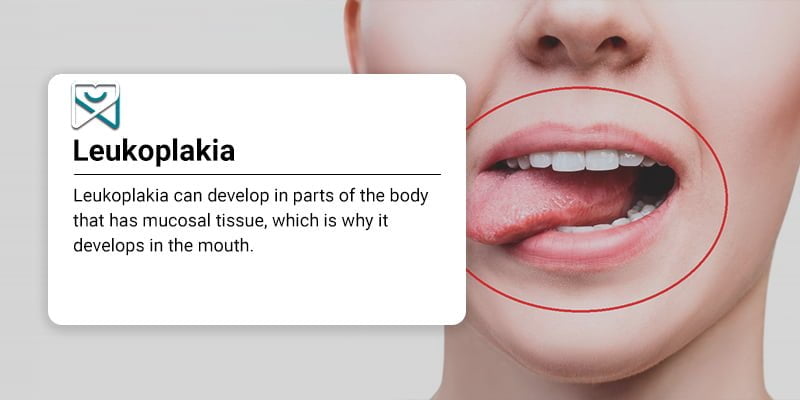

If you have leukoplakia, you will notice you have white and thickened patches on your:
Usually, the patches take several weeks to develop. It isn’t possible to remove the patches by scraping.
It’s not quite clear what causes leukoplakia, but it’s thought to be due to chronic irritation often caused by tobacco use.
It doesn’t matter what kind of tobacco you use as you can smoke, dip, or chew it, but it seems to be the main culprit in the development of leukoplakia.
There are other causes of leukoplakia, such as:
Leukoplakia can develop in parts of the body that has mucosal tissue, which is why it develops in the mouth.
The condition causes unusual-looking patches that can vary in appearance. Sometimes they can look:
The surface of these patches can be:
There is also another condition called hairy leukoplakia that causes hairy or fuzzy patches to develop in the mouth. The main cause of hairy leukoplakia is the Epstein-Barr virus, and once you have this virus, it remains in the body permanently but is usually dormant, and is more likely to affect people with immune problems or who have HIV. It’s rare for leukoplakia to be painful.
Most often, leukoplakia is not harmful and the patches are non-cancerous or benign.
However, you cannot take this for granted as some can show early signs of cancer. Cancers affecting the floor of the mouth can sometimes develop next to patches of leukoplakia. If patches of leukoplakia look red, it could be a sign of cancer and it’s important to see your dentist immediately.
You must see a dentist immediately if you notice:
You must also seek medical help if:
Although leukoplakia doesn’t usually cause any pain, it can indicate a more serious problem so please don’t ignore these signs.
Sometimes leukoplakia is mistaken for oral thrush, which is a yeast infection in the mouth. Oral thrush creates soft white patches that bleed more easily than leukoplakia patches, which is why it’s important to get a proper diagnosis from your dentist.
When you see your dentist Dr. Shalman, he can usually diagnose leukoplakia by examining your oral tissues.
If necessary, they may wish to carry out other tests to confirm this condition. If a patch looks at all suspicious, your dentist might want to do a biopsy, removing a small section of tissue for examination by a pathologist. This is to check for signs of precancerous cells.
There are two ways dentists can perform a biopsy:
Also, if the diagnosis is positive for cancer, your dentist may have removed the entire patch of leukoplakia during the biopsy and there could be no need for further treatment.
Most often, leukoplakia patches improve without any treatment, but it can be useful to avoid triggers that may have caused them in the first place such as using tobacco.
If your dentist thinks leukoplakia is related to irritation, they may suggest other treatments, including:
If your dentist took a biopsy, and it comes back as being positive for oral cancer, it is necessary to have immediate treatment to remove the patch of leukoplakia to prevent the cells from spreading. There are several ways this can be achieved as sometimes leukoplakia patches are removed by freezing them, or laser therapy is another non-invasive and very gentle way to get rid of leukoplakia.
Alternatively, it may be necessary for the patch to be excised using a scalpel. Hairy leukoplakia doesn’t usually cause mouth cancer and doesn’t normally need removing. However, your dentist may suggest using anti-viral medication to prevent the patches from growing.
There are also topical ointments that contain retinoic acid that can help reduce the size of the patch.
Often leukoplakia can be prevented by making some lifestyle changes, such as:
For more information about Leukoplakia treatment at Shalman Dentistry, visit our dentistry center in New York, book a dentist appointment or call us: (212) 658-1093
Shalman Dentistry
44 W 10th St #1A
New York, NY 10011
(10th St, between 5th & 6th Avenue)
☎ (212) 658-1093
Get Directions (Map)